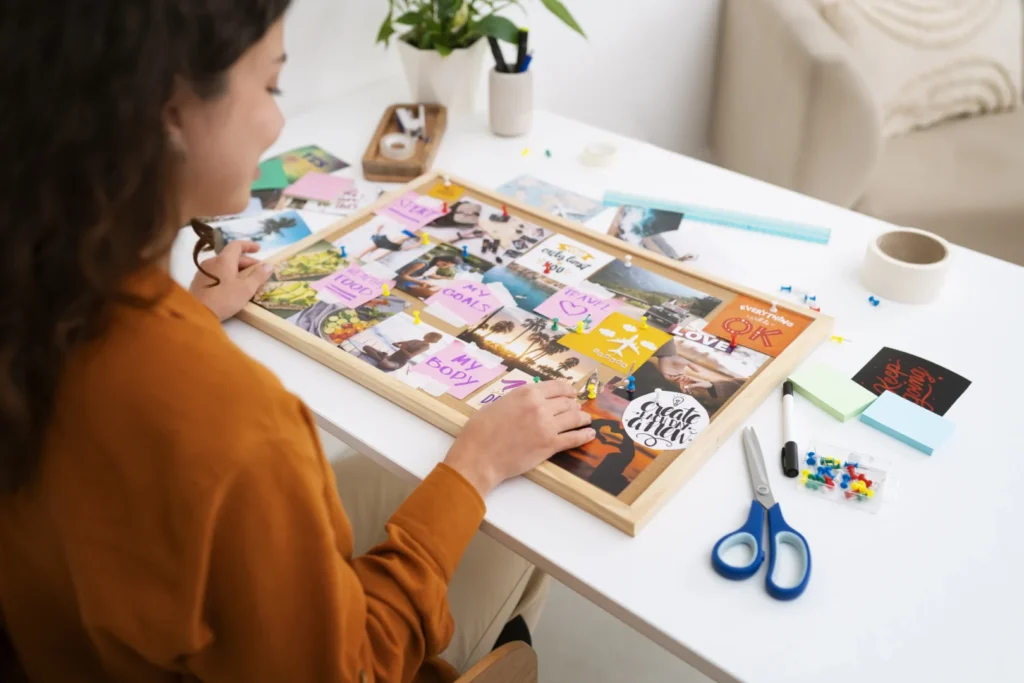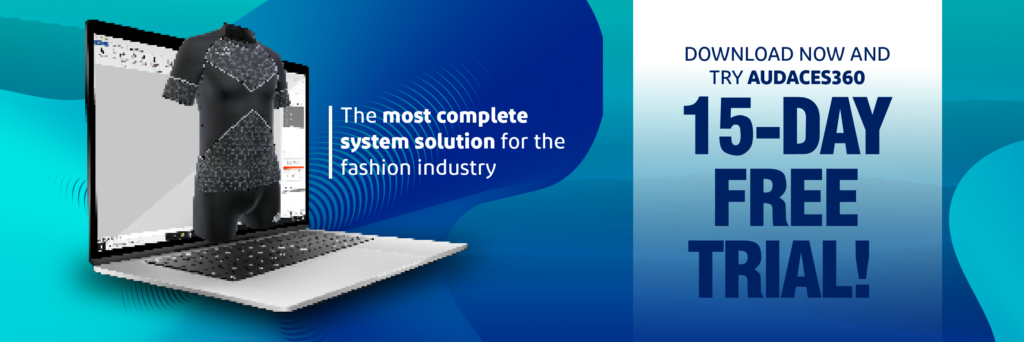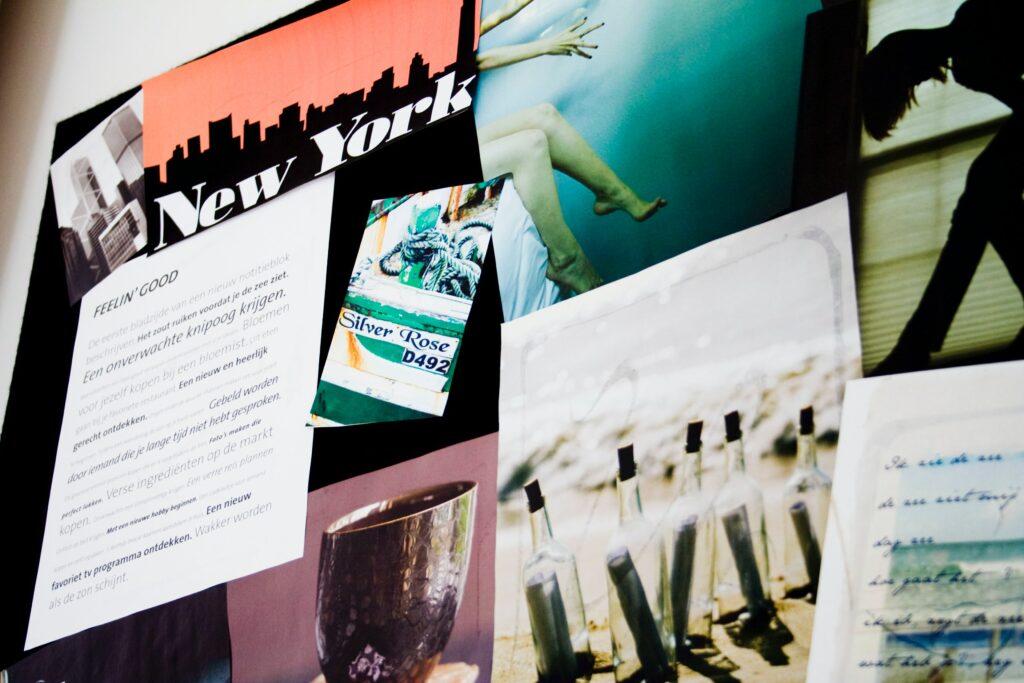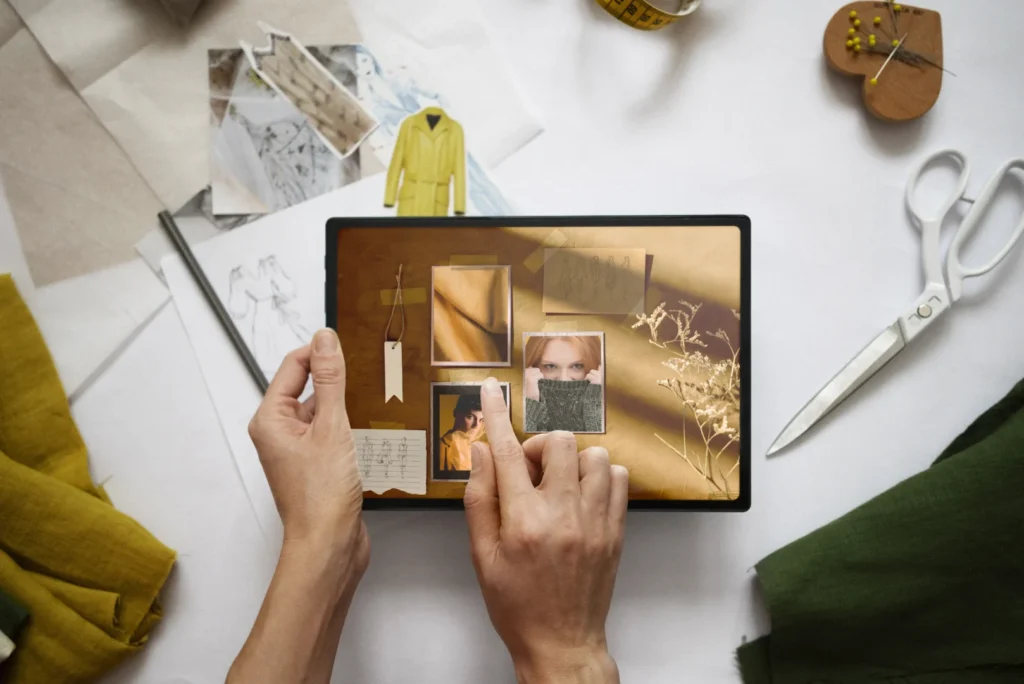Summary
- Mastering how to create a moodboard is a fundamental creative expertise in the fashion world.
- A moodboard is a versatile canvas that encompasses many references and materials, whether manually or digitally assembled.
- Audaces simplifies the moodboarding process. Ignite your creativity with a free trial of the Audaces360 multi-solution today.
Knowing how to create a moodboard is a vital skill in the world of fashion design. From defining your project’s theme to selecting the perfect platform, this article will guide you through the step-by-step process of curating a moodboard.
This creative tool not only captures your vision but also enhances collaboration within your design team.
Discover the power of visual storytelling as you explore both digital and physical tools, gaining tips on how to optimize your creative process.
And don’t forget to infuse your moodboard with colors, textures, and inspiration from various sources – we’ll cover everything in detail next!
Wishing you an insightful read!
What is a moodboard?

Before discovering how to create a moodboard, it’s crucial to grasp its essence. In English, a moodboard is often referred to as a “mood board,” a “wall of inspiration,” or a “semantic panel”.
Essentially, it functions as a visual representation of a creative project, capturing concepts through images, colors, or phrases. The purpose of a moodboard is to articulate and convey the overall ambiance of your creation.
You have the option to craft your moodboard digitally using tools such as Photoshop or Canva, allowing you to compile and organize references.
Sumário
Alternatively, you can embrace the traditional approach of physically assembling your moodboard with collages, photos, scents, and other elements that align with your vision.
Learn more: Find out how to use the chromatic circle to boost your fashion collection
What is the role of a moodboard?
A moodboard serves as a transformative tool, turning a blank canvas into a visual representation infused with elements and images that encapsulate the atmosphere and emotion of your envisioned project.
This technique greatly aids in effectively communicating your idea to others.
This approach is invaluable for professionals in various creative fields such as advertising, design, styling, architecture, marketing, and anyone engaged in creative processes.
The utility of a moodboard lies in its effectiveness, providing substance to what was once confined to the realms of planning and imagination.
But how do you create a moodboard? You might be wondering. Read on, and we’re going to show you everything!
Learn more: 17 hot Spring/Summer trends for your 2024 fashion collection
How does a moodboard help in creating a fashion collection?
When creating a fashion collection, the initial step involves developing a concept for it. During this process, conducting thorough research and gathering references are crucial.
Each of these references acts as a building block, akin to a letter contributing to the visual narrative of inspiration you aim to convey.
Understanding how to create a fashion moodboard is pivotal, as it serves as a tool for organizing ideas, defining styles, and guiding visual elements.
The references curated on the semantic panel contribute to translating the overall atmosphere of the project.

What to include on a moodboard?
When discovering how to create a moodboard, first, it is necessary to define the area, topic, and objective of the project.
Another aspect is establishing the color palette, which should directly relate to the creative concept you aim to convey.
You need to decide on the tool with which you will create the semantic panel. It’s important to note that a moodboard can be either online or physical.
Before the digital era, professionals utilized the collage process to build their murals. Nowadays, however, it is possible to assemble a reference board much faster, drawing from an infinite number of readily available references on online platforms.
See examples below of what to include in a moodboard of your own:
Images
These can include photographs, illustrations, or even sketches that capture the desired aesthetic, color schemes, textures, and overall mood. For example, if you’re creating a moodboard for a fashion collection inspired by nature, you might include images of lush greenery, floral patterns, or earthy tones.
Learn more: What are the 7 fashion styles and how to apply them to your collection?
Videos
Incorporating videos adds a dynamic dimension to your moodboard. Short clips or animations can convey movement, atmosphere, or specific details that static images might not capture.
Phrases
Phrases or text elements on a moodboard serve to articulate and emphasize the conceptual aspects of your project. This can include quotes, keywords, or descriptive phrases that encapsulate the mood or message you want to convey.
Components that serve as references
Beyond images, videos, and phrases, a moodboard may include specific components that directly reference the project’s theme. If the moodboard is physical, this could involve material swatches, fabric samples, or even three-dimensional objects that represent key elements of your concept.
After all, how to create a moodboard?

In the realm of fashion, a moodboard serves diverse purposes across various projects. Its primary utility is evident in the creation of collections, though it also proves valuable in the brand-building process and fashion editorials.
Moreover, it aids in effectively communicating your business.The goal is for the moodboard to act as a foundation and inspiration for constructing the concept, drawing from elements that abstractly convey the intended message.
1. Choose the type of moodboard
There are various platforms for creating a moodboard, but the initial decision is whether to opt for an online panel or a physical one. Online tools typically offer editable semantic panels organized by topic and structure, allowing immediate editing.
Digital options include platforms like Canva, Photoshop, or even a simple presentation software. For a physical moodboard, gather materials like a board, glue, scissors, and printouts.
Also, make sure to clearly define the purpose and theme of your project. Whether it’s a fashion collection, interior design, or any creative endeavor, having a clear concept will guide your moodboard creation.
2. Gather the most varied references
Collect a variety of inspiration sources. This can include images, videos, magazine clippings, and anything else that resonates with your project’s theme. Explore online platforms, Pinterest, or physical materials that inspire you.
Utilize the moodboard for creating specific pieces by including fabrics, prints, or images of reference looks.
However, the primary objective is to convey the overall idea of the collection. Include photographs, cultural references, and inspirational collections from other designers working on similar themes.
If there’s a key element inspiring your collection, invest in images or illustrations related to that component. As said before, phrases from personalities aligned with the concept being created can also enhance your moodboard.
Learn more: Uncover the benefits of fashion trend forecasting for your clothing business
3. Define the color palette and main style of your collection
Colors play a pivotal role in visual identity, so leverage technological resources to craft a color palette that aligns with your moodboard.
Consider the meaning of each color and how they behave within visual arts. The right color choices can significantly impact the appeal to consumers.
Ensure your color palette is well-represented. If there are specific colors associated with your theme, make sure they are integrated harmoniously.
Equally important is typography, as the font conveys different sensations. Explore and choose a font that best suits and communicates your ideas without hesitating to experiment.
Learn more: How to create a clothing color chart to elevate your collection
4. Review and refine the material
Take a comprehensive look at the collected material, similar to reviewing a written text, checking for coherence and cohesion in the proposed idea.
Ask yourself if the message is clear, if any elements are missing, and if the proposal is well-supported.
Make any necessary adjustments to ensure it accurately reflects your vision and effectively communicates the mood and inspiration for your project.
Seeking a third person’s perspective can provide valuable insights into whether your idea is effectively transmitted.
Types of moodboards
From the tactile nature of physical moodboards, where fabrics come to life on boards, to the digital realm, harnessing the flexibility of online platforms, let’s explore the distinctive characteristics of each type:
Physical moodboard
The physical moodboard is constructed on a canvas, blackboard, or panel where you can affix fabric swatches, clippings from color catalogs, as well as photos and images from magazines and books.
This approach allows for a hands-on, tangible representation of your creative vision, enabling you to arrange and visualize elements in a physical space.
Digital moodboard

The digital moodboard is created using various online tools. These platforms often provide editable semantic panels that are organized by topic and structure.
This type allows for a more dynamic approach, as you can easily rearrange, resize, and experiment with different elements.
In the case of a digital moodboard, there are various tool options from which you can choose.
1) Canva
Canva stands out as one of the most intuitive editing programs, offering a simple and user-friendly interface for image editing. It enables the easy separation and grouping of your inspirations into a pre-designed panel, streamlining the process of creating your moodboard.
2) Pinterest
Pinterest serves as a powerful tool for visual reference searches. Its easily navigable platform allows for the seamless saving and organization of references within the application, eliminating the need to switch between different tools.
3) Photoshop
A veteran in the design world, Photoshop remains a valuable resource for creating versatile moodboards. For those seeking Photoshop reference panel mockup packages, Envato Elements is a helpful source offering everything from photo collage templates to Instagram mockups and fashion moodboards.
4) GoMoodBoard
True to its name, GoMoodBoard is a free and user-friendly tool. You can start creating on a blank canvas, adding your images and comments to the chart. Beyond its ease of use, the panel is editable and shareable at your convenience.
5) Adobe Spark
Adobe Spark provides easy-to-use tools for creating moodboards and other visual content. With customizable templates, it allows you to incorporate images, text, and colors seamlessly.
6) MURAL
An online workspace that supports visual collaboration, MURAL is suitable for creating digital moodboards and allows teams to work together in real-time.
Unlock the secrets of crafting a dynamic moodboard with Audaces
Embark on a journey of creativity and efficiency with Audaces Isa, a tool designed to revolutionize the way you plan your collections. Create visual collection maps, defining each stage clearly to ensure your entire team is aligned with your vision.
Audaces Isa goes beyond, allowing you to track the production of each design, creating a comprehensive history that serves as a foundation for future collections.
Mastering how to create a moodboard becomes indispensable in organizing your creative process and effectively conveying your inspirations.
This simple yet powerful tool serves as a visual summary of the aesthetic references driving the concept of your new collection, enabling you to guide your team in a cohesive and collaborative manner.
Well, we trust that this article has provided you with valuable insights. Now, unleash your creativity and elevate your design process with Audaces!
How about exploring the elegance and artistry of Italian luxury fashion for further inspiration?
Download our free e-book and delve into the distinctive identities and unique styles of fashion icons like Elsa Schiaparelli, Valentino Garavani, Giorgio Armani, Miuccia Prada, Domenico Dolce, and Stefano Gabbana:
FAQ
To create a moodboard, define your project’s theme, gather diverse inspiration, and choose a platform (physical or digital). Select key images, organize them and consider color palettes and styles.
A moodboard serves as a visual roadmap, consolidating aesthetic references and inspirations to guide the development of a creative project. It aids in effective communication, aligning teams and ensuring a cohesive vision.
Popular platforms like Canva, Pinterest, and Photoshop are widely used for crafting digital moodboards. Each offers unique features, allowing users to curate and organize visual elements online.






